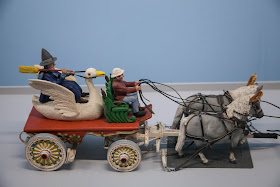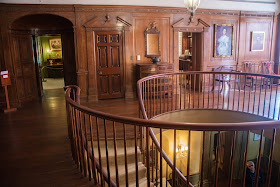While in Vermont, we visited the fascinating and unique Shelburne Museum, which is a museum of art, design, and Americana. Over 150,000 works are exhibited in 39 exhibition buildings, 25 of which are historic and were relocated to the Museum grounds. It is located on 45 acres near Lake Champlain.
Electra Havemeyer Webb was a pioneering collector of American folk art and founded Shelburne Museum in 1947. The daughter of Henry Osborne Havemeyer and Louisine Elder Havemeyer, important collectors of Impressionism, European and Asian art, she exercised an independent eye and passion for art, artifacts, and architecture celebrating a distinctly American aesthetic.
When creating the Museum she took the step of collecting 18th and 19th century buildings from New England and New York in which to display the Museum's holdings, relocating 20 historic structures to Shelburne. These include houses, barns, a meeting house, a one-room schoolhouse, a lighthouse, a jail, a general store, a covered bridge, and the 220-foot steamboat Ticonderoga.
In Shelburne, Mrs. Webb sought to create "an educational project, varied and alive." Shelburne's collections are exhibited in a village-like setting of historic New England architecture, accented by a landscape that includes over 400 lilacs, a circular formal garden, herb and heirloom vegetable gardens, and perennial gardens.
Shelburne Museum’s purpose is to enrich people’s lives through art, history and culture. The collection of approximately 150,000 objects is one of the most extensive and varied collections in the US and is notable for its great range, quality and depth. The outstanding collections of fine, folk and decorative art celebrate American ingenuity, creativity and craftsmanship.

It would take days to see everything this one-of-a-kind museum has to offer, and we only had a few hours. We made a plan of the top things we wanted to see, at the top of that list was the circus building which houses a collection of circus posters, Gustav A. Dentzel Carousel animals, and elaborately carved miniature circuses, including those by Roy Arnold and Edgar Kirk.
In the 1950s the Museum conceived of the design for the Circus Building, completed in 1965, to meet the requirements of exhibiting the five-hundred-foot-long Roy Arnold miniature circus. Traversing the grand hallway of the large horseshoe-shaped, spruce and cedar structure gives the impression of walking through the entire concourse of a circus parade.
One of the main attractions in the circus building are the gorgeous carousel animals. The German-born Dentzel opened America’s first carousel business in 1867. Detnzel’s shop produced the most realistic and graceful of all carousel animals; his carvers paid enormous attention to anatomical detail and his painters rendered every nuance of the animals’ coloration. Shelburne Museum’s Dentzels are from a forty-animal carousel completed about 1902. The three-row machine carried twenty-nine horses and four chariots; menagerie figures include giraffes, goats, deer, lions and tigers.
The figures were finish-carved by Daniel Muller, the most skilled of Dentzel’s craftspeople. All the animals are in their original factory paint; this is almost unheard of for carousel figures because most carousels were repainted frequently as part of routine maintenance. Several of the figures have recently been conserved; layers of discolored, non-original linseed oil were removed to reveal the richly colored and complex paint patterns applied by Dentzel’s masterful painters.


The other main attraction, for which the building needed its unusual design, is the 500 foot long miniature circus parade. This remarkable project was begun in 1925 by Roy Arnold (1892-1976) of Hardwick, Vermont. Built on a one-inch to one-foot scale, the parade required thirty years to complete. Four other skilled woodcarvers, Harry T. Prior, Charles W. Dech, Milo Smith and Charles Lockier, worked with Arnold on the parade, which features accurate reproductions of wagons actually used by circuses of the Golden Age.
It was so hard not to take and post photos of every inch of this folk art masterpiece. I loved every wagon, every figure, every horse. So, even though it may seem like a lot of photos, I held back quite a bit.
There was a fairytale section with wagons representing different stories!
The Kirk Bros. Miniature Circus is a complete three-ringed folk art circus created by Edgar Decker Kirk (1891-1956) of Harrisburg, Pennsylvania, over a period of forty-six years. Kirk, who worked as a brakeman on the Pennsylvania railroad, began the circus in 1910 when his children were small and continued to work on it long after they were grown, until 1956. Working at night after twelve-hour days with the railroad, Kirk cut the figures for his circus from scrap lumber on a treadle-operated jigsaw and completed the carving with an ordinary penknife. Only the nails and paint were specially purchased. The Kirk circus, complete with animals acts, clowns, trapeze artists, bands, side shows and bleachers full of spectators and vendors, is a monument to Kirk’s creativity, ingenuity and lifelong passion for the circus.
Next on our, "must see list" was the massive steamboat, the Ticonderoga. Ticonderoga is one of two remaining side-paddle-wheel passenger steamers with a vertical beam engine of the type that provided freight and passenger service on America's bays, lakes and rivers from the early 19th to the mid-20th centuries. Commissioned by the Champlain Transportation Company, Ticonderoga was built in 1906 at the Shelburne Shipyard in Shelburne, Vermont on Lake Champlain.
The other is the Eureka, built as the Ukiah for the Northwestern Pacific Railroad in California, renamed after a post-World War I reconstruction.
The ship's crew numbered twenty-eight, including the captain, pilots, mate, deckhands, engineers, and firemen to operate the boat. The purser, stewardess, freight clerk, bartender, hall boys, cook, waiters, scullion, and mess boys attended to passengers and freight arrangements.
Initially, Ticonderoga served a north-south route on Lake Champlain. Daily, she docked at Westport, New York, where she met the New York City evening train. The next morning she carried travelers and freight northward to St. Albans, Vermont. In addition to passengers, Ticonderoga transported local farm produce, livestock, and dry goods on a regular basis, and during both world wars ferried U.S. troops between Plattsburgh, New York and Burlington, Vermont. Over the years she also operated on the east-west run from Burlington to Port Kent, New York and had a brief career as a floating casino.
When more modern ferries made her obsolete, Ticonderoga managed to persist in operation as an excursion boat for several years; however, by 1950 the steady decline in business threatened her future. Ralph Nading Hill saved Ticonderoga from the scrap heap when he persuaded Electra Havemeyer Webb to buy her for her growing museum.[3] While the Shelburne Museum attempted to keep her in operation, the steamboat era had passed making it difficult to find qualified personnel to operate and maintain the aging vessel.
Today, the Ticonderoga portrays life on board in 1923. The ship’s carved and varnished woodwork, gilded ceilings, staterooms, grand staircase, and dining room evoke the elegance of steamboat travel.
After touring through the beautiful interior of the Ticonderoga Steamboat, our little band of three split up as we had different things we wanted to see. I wandered around to look at as many of the buildings as possible. I ended my tour of the museum by going through the Electra Havemeyer Webb Memorial building.
The structure is a Greek Revival design based on a house in Orwell, Vermont, that Mrs. Webb admired. After her death in 1960, her children built the gallery to fulfill her wish that her Impressionist paintings and decorative arts come to the Museum. The building was completed in 1967. Today it houses the museum’s world-renowned collection of French Impressionist masterpieces
While other buildings on the Museum campus provide insight into Mrs. Webb’s mature interests as a collector, the Electra Havemeyer Webb Memorial Building tells something of the forces that influenced her upbringing and personal life. The interior is a painstaking recreation of six rooms from Mrs. Webb’s 1930s Park Avenue apartment in New York City. The rooms are a formal combination of English, European, and Asian furniture and decorative objects as well as high-style American pieces, including an elegantly carved suite of furniture by Louis Comfort Tiffany (1848-1933).
As mentioned earlier, it would take days to see this fascinating museum in its entirety, but I loved our afternoon here. It was so much fun exploring and learning about all kinds of new things.
































































